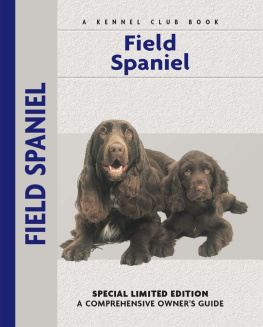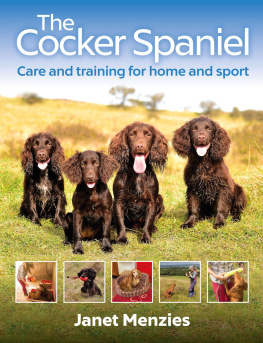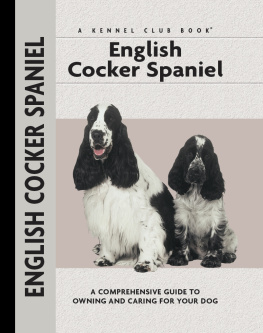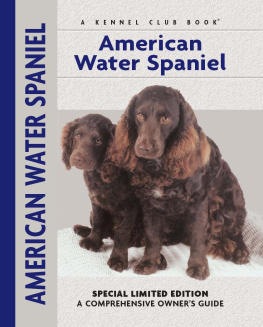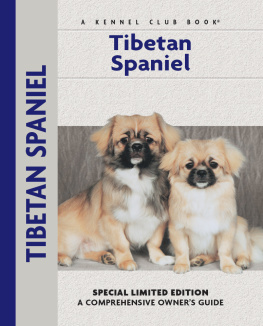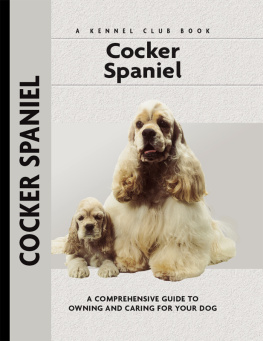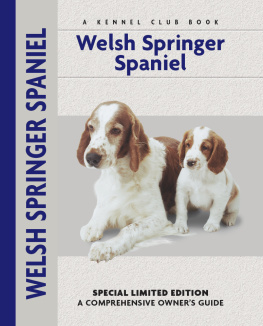Physical Characteristics of the Field Spaniel
(from the American Kennel Club breed standard)
Head and Skull: The occiput is distinct and rounded. Brows are slightly raised. The stop is moderate, but well defined by the brows.
Ears: Set on slightly below eye level: pendulous, hanging close to the head; rolled and well feathered.
Eyes: Almond in shape, open and of medium size; set moderately wide and deep.

Nose: Large, fleshy and well developed with open nostrils.
Neck: Long, strong, muscular, slightly arched, clean and well set into shoulders.
Muzzle: Strong, long and lean.
Bite: Scissors or level, with complete dentition. Scissors preferred.
Forequarters: Shoulder blades are oblique and sloping. The upper arm is closed-set; elbows are directly below the withers. Forelegs are straight and well boned to the feet. Pasterns are moderately sloping but strong. Feet face forward and are large, rounded and webbed, with strong, well arched, relatively tight toes and thick pads.
Body: The depth of chest is roughly equal to the length of the front leg from elbow to ground. The rib cage is long and extending into a short loin.
Color: Black, liver, golden liver or shades thereof, in any intensity (dark or light); either self-colored or bi-colored.
Topline: The neck slopes smoothly into the withers; the back is level, well muscled, firm and strong; the croup is short and gently rounded.
Loin: Short, strong and deep, with little or no tuck up.
Tail: Set on low, in line with the croup, just below the level of the back.
Hindquarters: Strong and driving; stifles and hocks only moderately bent. Hocks well let down; pasterns relatively short, strong and parallel when viewed from the rear. Hips moderately broad and muscular; upper thigh broad and powerful; second thigh well muscled.
Coat: Single; moderately long; flat or slightly wavy; silky; and glossy; dense and water-repellent.
Size: Ideal height for mature adults at the withers is 18 inches for dogs and 17 inches for bitches.

Contents

Trace the evolution of the original Spanyells and document the development of todays Field Spaniel. See how the breed survived the changing trends, World Wars, apathy and cross-breedings to become the modern working, competition and companion dog that the Field Spaniel is today. Meet the original breeders and foundation dogs credited with saving todays breed.

Make the acquaintance of a fun-loving, good-humored breed of working gundog that delights fanciers around the world. Discover the traits that make the Field Spaniel one of the dog worlds best kept secretsits stable, delightful temperament; its love of family; its determination, intelligence and sense of comic timing; and many other hidden talents!

Learn the requirements of a well-bred Field Spaniel by studying a description of the breed based on the authors explanation of the breed standards set forth by the worlds major kennel clubs. Both show dogs and pets must possess key characteristics as outlined in the standards.
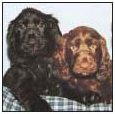
Find out about how to locate a well-bred Field Spaniel puppy. Discover which questions to ask the breeder and what to expect when visiting the litter. Prepare for your puppy-accessory shopping spree. Also discussed are health concerns for the puppy-buyer, home safety, the first trip to the vet, socialization and solving basic puppy problems.
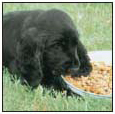
Cover the specifics of taking care of your Field Spaniel every day: feeding for the puppy, adult and senior dog; grooming, including coat care, ears, eyes, nails and bathing; and your Fields exercise needs. Also discussed are dog ID, safe travel and boarding.

Begin with the basics of training the puppy and adult dog. Learn the principles of house-training the Field Spaniel, including the use of crates and basic scent instincts. Get started by introducing the pup to his collar and leash and progress to the basic commands. Find out about obedience classes and other activities.

By Lowell Ackerman DVM, DACVD
Become your dogs healthcare advocate and a well-educated canine keeper. Select a skilled and able veterinarian. Discuss pet insurance, vaccinations and infectious diseases, the neuter/spay decision and a sensible, effective plan for parasite control, including fleas, ticks and worms.

Know when to consider your Field Spaniel a senior and what special needs he will have. Learn to recognize the signs of aging in terms of physical and behavioral traits and what your vet can do to optimize your dogs golden years.
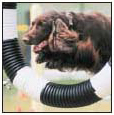
Step into the center ring and find out about the world of showing pure-bred dogs. Heres how to get started in AKC shows, how they are organized and whats required for your dog to become a champion. Take a leap into some of the popular performance events in which the Field can compete.
K ENNEL C LUB B OOKS F IELD S PANIEL
ISBN 13: 978-1-59378-291-7
eISBN 13: 978-1-62187-027-2
Copyright 2006 Kennel Club Books An Imprint of I-5 Press A Division of I-5 Publishing, LLC
3 Burroughs, Irvine, CA 92618 USA
Cover Design Patented: US 6,435,559 B2 Printed in South Korea
Library of Congress Cataloging-in-Publication Data
Hirschy, Becki Jo.
Field spaniel / by Becki Jo Hirschy.
p. cm.
ISBN 1-59378-291-8
1. Field spaniel. I. Title.
SF429. F36H57 2006
636.752'4--dc22
2006011584
10 9 8 7 6 5 4 3 2 1
Photography by Carol Ann Johnson
with additional photographs by:
Norvia Behling, Booth Photography, Paulette Braun, Alan and Sandy Carey, David Dalton, Isabelle Franais, Kylie Hirschy, Bill Jonas, D. Kay Klein, Joseph Pichette, Steve Sherouse, Shula Shipton, Jane Swanson, Sue Thornhill, Tien Tran Photography, Otto Wahl, Lisa Winters, F. E. Wolkenheim and L. Zobel.
Illustrations by Patricia Peters.
Next page
